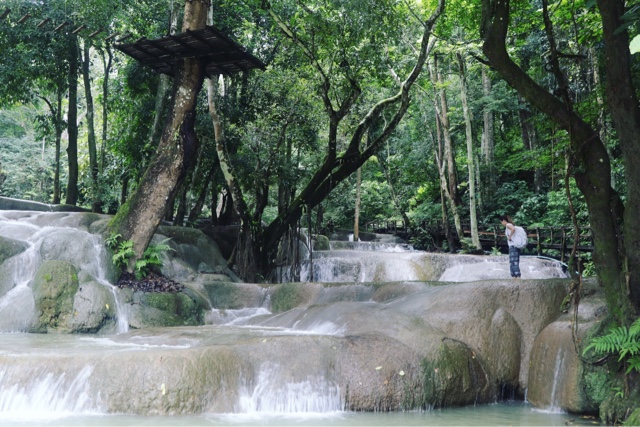


Luang Prabang is renowned for Buddhist temples of outstanding beauty with Wat Xieng Thong an outstanding example.

The tree portrays the tale of the founding of the temple which legend states was by two hermits who decided to create the sanctuary next to a large flame tree where the rivers met.
Mount Phousi

The hill is popular as a place to watch the sun rise or set over the Mekong River. From the summit you can enjoy a spectacular 360 degree outlook across the city and its many temples, and out over the surrounding landscape to the mountains in the distance.
Tad Sae Waterfall

Tad Sae Waterfall is a spectacular natural wonder best appreciated in the wet season.

Despite not being as high as Kuang Si waterfall there are many more streams of water which cascade and make a thunderous sound following plenty of rain.

The falls pour over beautiful limestone formations across a variety of levels into large pools below, which are fantastic to swim in.
Vientiane
Buddha Park

Buddha Park (aka Xieng Khuan) is a famous sculpture park with more than 200 religious statues including a huge 40-metre high reclining Buddha image.
The entrance is crafted to look like a demon’s mouth (about three metres high) with a stone ladder inside leading to a bird’s eye view of the entire Xieng Kuan Park.

The best spot for photography here is on top of the giant pumpkin structure standing about three stories high.
That Luang

The beautiful architecture is in Lao style, influenced by Buddhist beliefs – these include finely-gilded, red-lacquer doors, pointed lesser stupas, many Buddha images and beautiful flower and animal images.
Patuxai Victory Monument

Situated at the end of one of the capital’s grand avenues, the large, square arch is reminiscent of the Arc de Triomphe in Paris. However, as a monument to Laos’ resilience and eventual independence, Patuxai was designed to pay homage to its national culture and traditions. Its exterior embellishments feature both Buddhist religious symbols such as lotus leaves and the stupa-shaped towers, and statues of animist kinnari (half-female and half-bird figures) and nagas (dragons).
Wat Ho Phra Keo

Even without the Emerald Buddha, however, Ho Phra Keo is well worth a visit. The only part of the old royal palace that has survived, the temple is no longer used for religious purposes and is now a museum. The Temple of the Emerald Buddha, as it is often known in English, is richly adorned with carved wooden features, a magnificent 16th century lacquered door with Hindu carvings, numerous Khmer stone carvings and a variety of Buddha statues.


Statue of King Anouvong the Chao, green areas with some street stalls. Start at the Presidential Palace and walk to the statue of King Chao Anouvong, once in the statue of the King, walk towards the West until the end of the promenade along the river, place where market night of Vientiane (night market) mounts each day.
Palais Presidentiel

The Presidential Palace of Vientiane is a beautiful French Beaux Arts style that serves as the President official residence of Laos and also is the scene of official acts. Surrounded by gardens and located on the main avenue of Vientiane, the Lane Xang Avenue, Vientiane Presidential Palace is a building in the year 1973.
Wat Si Muang

Wat Si Muang is one of Vientiane’s most popular sites of worship, and offers a fascinating insight into how old animist beliefs have blended seamlessly with Theravada Buddhism.
Food is generally inexpensive in Laos. Lao food owes its distinctive taste to fermented fish sauce, lemongrass, coriander leaves, chillies and lime juice.






Fried Kuey Teow
